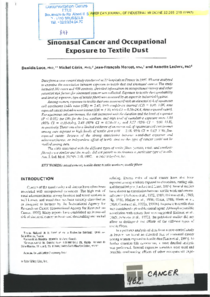Sinonasal cancer and occupational exposure to textile dust

Luce, Danièle ; Gérin, Michel ; Morcet, Jean-François ; Leclerc, Annette
American Journal of Industrial Medicine
1997
32
3
205-210
dust ; epidemiologic study ; exposure ; hospital ; nasal cancer ; occupational disease ; textile
Occupational diseases
English
Bibliogr.
The association between occupational exposure to textile dust and sinonasal cancer was examined. Confirmed cases of sinonasal cancer (207), 323 hospital controls with cancers of other sites, and 86 controls provided by the cases, were interviewed concerning demographics, lifestyle, and occupational history. An industrial hygienist assessed the occupational exposure information for exposure to textile dust. Odds ratios (ORs) were calculated using the controls as a reference. Among women, the risk of squamous cell carcinoma increased with exposure duration and concentration and age at first exposure. ORs of 3.00 and 3.57 were calculated for the cancer risk of women in the highest average and cumulative exposure categories, respectively. For men, an elevated OR of 2.18 was determined for cancer risk in the high cumulative exposure category. After assuming induction periods of 5, 10, and 20 years, the ORs for women with high cumulative exposure levels equaled 3.58, 3.62, and 4.09, respectively. Cancer risk was elevated among women and men with medium/high level exposure to synthetic fibers, with ORs of 6.93 and 4.12, respectively. Among both men and women, the ORs were lower for exposure to cotton dusts than for exposure to wool dusts. Nearly all of the male cases with adenocarcinomas were exposed to wood dust. Exposure to textile dust did not appear to increase the cancer risk associated with wood dust. For women with adenocarcinomas, an OR of 3.70 was determined for exposure to textile dust. The authors conclude that this study supports an association between textile dust exposure and sinonasal cancer, especially among women.
Digital
The ETUI is co-funded by the European Union. Views and opinions expressed are however those of the author(s) only and do not necessarily reflect those of the European Union or the ETUI.